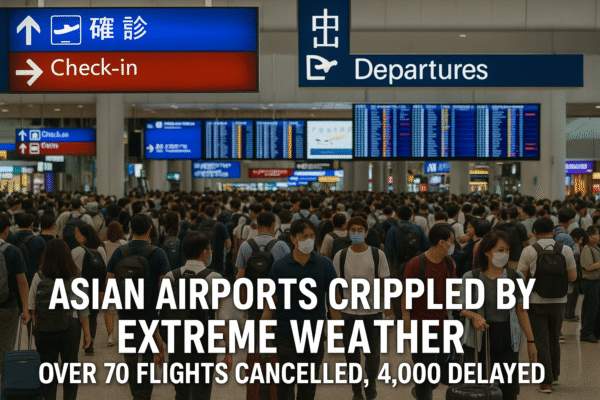The global tourism industry is facing a new crisis in 2025, as a wave of major travel destinations—led by Cuba, the United States, Costa Rica, Iceland, Ireland, Croatia, Sweden, and Thailand—report a dramatic drop in international arrivals, hotel occupancy, and tourism revenue. According to a recent report by Oxford Economics and supported by national data sources, these eight countries—many of which were once among the most visited worldwide—are now struggling to regain footing amid rising travel costs, visitor safety concerns, energy crises, and tightening visa rules.
Cuba’s Tourism Crisis Deepens
Cuba is experiencing its most significant tourism downturn in nearly 20 years. According to data from the Oficina Nacional de Estadísticas e Información (ONEI), the country welcomed just over 991,000 international visitors between January and April 2025, a steep 27% decline year-over-year. Hotel occupancy in Havana and across major resort zones has plummeted to 24%, leaving nearly three-quarters of rooms empty during what is typically the island’s peak season.
Cuba’s two top markets—Canada (down 30%) and Russia (down 51%)—have contracted sharply, while efforts to grow Western European and Latin American arrivals have failed to yield significant recovery. The root causes include chronic energy shortages, declining service quality in hotels, and persistent U.S. sanctions which continue to hamper tourism infrastructure and investment. While Cuban authorities still aim for 2.6 million visitors in 2025, tourism experts and hoteliers increasingly see this figure as unrealistic under current conditions.
United States Sees Uncharacteristic Inbound Drop
The United States, traditionally the second-most visited country globally, is experiencing a rare downturn in inbound travel. In March 2025, international arrivals dropped 11.6%, while the first half of the year posted a modest but troubling 1.2% decline. According to Oxford Economics, visitor spending is expected to fall by $12.5 billion compared to 2024.
Major cities like New York and Miami are seeing hotel bookings down by over 60%, largely due to fewer arrivals from Europe, Canada, and Asia. Travel analysts point to high visa fees, slow processing times, political tensions, and an unfavorable exchange rate as core contributors to the U.S.’s declining global tourism competitiveness.
Costa Rica Struggles with Regional Pressures
Renowned for its ecotourism and biodiversity, Costa Rica is also facing headwinds. Government tourism data reveals a 7% drop in air arrivals in Q1 and a further 4.7% dip in May. The country is now in its seventh consecutive month of declining foreign arrivals.
Challenges include a rising crime rate, stronger local currency, and fewer direct flights from key source markets like the U.S. and Canada. While the Costa Rican Tourism Institute maintains that recovery is ongoing, industry insiders warn the slowdown could threaten small-scale tourism operators who rely on consistent high-season traffic.
Iceland Feels the Chill in Visitor Numbers
Even Iceland, a destination popular with adventure and nature travelers, has seen a tourism retreat. The Icelandic Tourist Board reported an 8.4% decline in outbound passengers from Keflavík International Airport in March. Additionally, February saw a 4.5% year-over-year drop in overnight stays.
The country’s tourism sector is also shrinking from within, with a 2% drop in employment in tourism-related industries. Shorter stays and last-minute cancellations are becoming more frequent, forcing local operators to reconsider expansion plans.
Ireland Faces Steep Slump Despite Promotions
In Ireland, tourism is in free fall. According to the Central Statistics Office (CSO), March 2025 arrivals fell 15%, and the first quarter saw a 23% decline versus 2024. Even aggressive campaigns by Tourism Ireland have failed to reverse this trend.
Public safety concerns in cities like Dublin, confusing data collection methods, and rising accommodation prices have been cited by tourists as deterrents. May added further concern with a 10% drop in arrivals and 8% reduction in overnight stays.
Croatia’s Coastline Sees Fewer Visitors
Once among the summer gems of Europe, Croatia is seeing sharp reductions in tourist numbers. The first quarter of 2025 recorded a 16.5% fall in international arrivals, with coastal destinations reporting booking declines of up to 33% in May.
Industry experts blame overdevelopment, higher pricing, and reduced service quality, which have led tourists to seek alternative Mediterranean destinations like Greece or Turkey. Croatia’s tourism board is now exploring season extension strategies and experience-based rebranding.
Sweden Faces Booking Setbacks
Sweden’s tourism optimism was quickly dampened in early 2025. Bookings dropped by 11.5%, particularly among Chinese and UK travelers. According to Visit Sweden, the reasons include visa delays for Schengen countries, stronger currency effects, and growing preferences for less costly alternatives in Eastern Europe.
Thailand’s Chinese Market Weakens
Thailand, once one of Asia’s tourism giants, is also suffering. Between January 1 and July 13, Thailand recorded 17.75 million international tourists, down 5.6% from 18.8 million in 2024. But the biggest concern is the massive drop in Chinese arrivals—down 32–50%, depending on the province.
In response, Thai authorities have postponed a tourist entry fee until 2026, hoping to ease access for budget-conscious travelers. Bangkok and Phuket, once crowded with tour groups, now report smaller group sizes and lower hotel occupancy.
A Global Tourism Wake-Up Call
As these diverse nations face economic turbulence, visa barriers, safety challenges, and shifting traveler preferences, 2025 is proving to be a pivotal year. While Spain, Mexico, and Vietnam are enjoying continued tourism growth, other destinations may need to revamp marketing, streamline entry processes, and invest in quality infrastructure if they are to reclaim their share of the global tourism market.
Without swift and strategic interventions, these tourism-reliant economies risk deeper revenue losses, job cuts, and regional instability as the global travel ecosystem continues to evolve.
For more travel news like this, keep reading Global Travel Wire



















